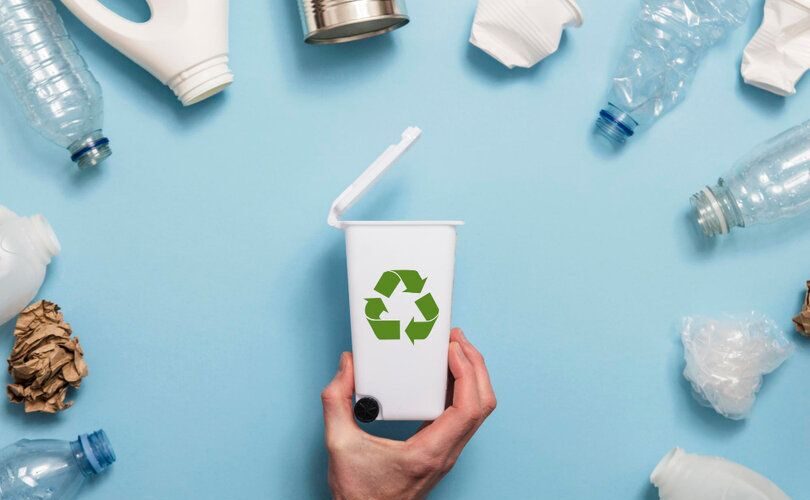In the 2008 Disney film Wall-E, a tiny robot finds himself alone on planet Earth, working to clean up a world decimated by trash and abandoned by humans who left it that way. Heartwarming as the film turns out, the underlying commentary of humanity’s problem with trash and plastic waste is the film’s most poignant theme. This is because it strikes at the heart of an issue that we’ve failed to get control of more than 15 years after the movie’s release: plastic pollution.
We live in the age of dawning artificial intelligence, commercialized space travel and the ability to edit the human genome, but we have yet to tackle closed-loop recycling.
According to research, in 2021, the U.S. fully recycled only about 5% of the nearly 51 million tons of plastic waste we generated. Unfortunately, plastic recycling is more complicated than we’ve been led to believe since plastic first rose to prominence in the 1960s. Many factors contribute to our misconceptions surrounding recycling in the U.S. Primarily, the plethora of plastic varieties—ranging from plastics that hold chemicals like antifreeze to plastics used in furniture or carpeting and plastics that hold food items like yogurt or berries—makes recycling incredibly challenging because sortation facilities often don’t know what exactly is in the plastic they are trying to recycle.
From there, the recycling processes themselves—the methods used to break down plastic and turn it into something that can be reused or repurposed—are often limited. The primary recycling method used for over 50 years is mechanical recycling. In this process, recyclable types of plastic are melted and turned into pellets to be sold and reshaped into new items. Unfortunately, this method only works on a very limited set of plastic varieties.
More recently, a second recycling process, known as chemical recycling, has emerged as a purported “game-changer.” This process makes it harder to recycle plastic types and uses solvents to break them down into molecular components that can then be used to make new plastic. While this new method of recycling has been celebrated by many large producers like L’Oréal, Proctor & Gamble and Nestlé, it has yet to be proven environmentally sustainable, safe (the solvent used is butane, which is highly flammable and potentially explosive) or operable at scale.
Regardless of recycling methodology, however, steps can be taken now to increase producer responsibility and the rate of closed-loop recycling, such as adding digital watermarks to plastic products to help with detailed sortation at material recycling facilities (MRFs).
The sortation technology that exists today can only identify, at a high level, some of the materials in each plastic, but it cannot identify the grade or complex composition of much of the plastic it works to sort. This means it cannot be sorted based on specifications that would allow plastics to be more easily reused, like whether a plastic is food-grade.
The good news is that proven technologies already exist to help solve these challenges, driving plastic circularity and reducing plastic pollution. Digital watermarking works by applying covert markings to products at the point of manufacture that are not visible to the human eye but are detectable by special scanners. These scanners can be embedded into existing sortation technology, allowing for more detailed sortation without facilities undergoing large infrastructural changes. When scanned, digital watermarks on packaging can be linked to data from the manufacturer on plastic composition, whether the plastic is food or skin grade, age or any other key information, and then sorted accordingly. With more detailed sortation comes greater data and even the ability for producers to buy back their own recycled material or recyclate. This, in turn, decreases the demand for virgin plastic.
For business leaders ready to make a difference in the recycling space, digital watermarking is an opt-in solution that leaders can elect to incorporate at any time. Digital watermarks can be imperceptibly embedded into packaging during the manufacturing process, which means that no new technology is needed to incorporate them as the digital watermarks are printed simultaneously with the packaging itself. Many companies elect to embed digital watermarks during a packaging design refresh to ensure streamlined technology integration.
Moreover, as the world moves toward enacting extended producer responsibility (EPR) laws regarding the recyclability of plastic products, digital watermarks can help producers meet changing sustainability regulations while also leading the way in building a greener world. The recycling economy becomes more effective as the number of companies utilizing digital watermarks increases. As a result, recycled plastic will become a viable alternative to virgin plastic in manufacturing.
With this in mind, we expect to see a greater demand for recycled plastic as more countries and U.S. states adopt EPR laws. The more companies that employ digital watermarks, the greater the supply of recycled plastic and the lower the cost. This is in tandem with growing consumer interest in buying more sustainable products, which is expected only to increase.
We live in an age where what once seemed impossible is now possible. It is time we start working collaboratively across industries and sectors to tackle the persistent and pervasive problem of plastic pollution, and there are solutions available today to help us do that. Digital watermarks allow producers to take meaningful steps toward creating a more sustainable world while deriving insights and accessing new data about their products and consumer behavior. The time to solve plastic pollution is now, and we must use every tool we have at our disposal—so long as we don’t try to solve one environmental problem by creating others.

